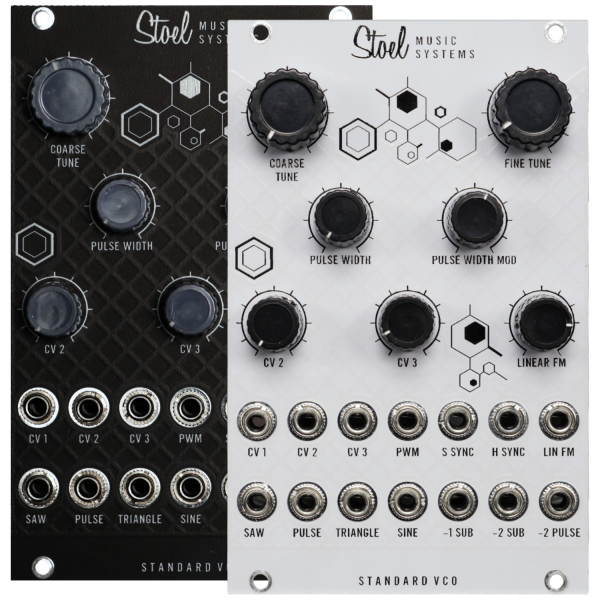We use cookies to make your experience better. To comply with the new e-Privacy directive, we need to ask for your consent to set the cookies. Learn more.
Standard Oscillator
The Stoel Music Systems Standard VCO is a versatile oscillator with a variety of controls and outputs. Coarse and fine tuning controls are provided for a wide range of accurate tuning. The CV 1 jack follows a 1 volt per octave scale. Knobs control the scale of the CV 2 and CV 3 jacks.
The pulse waveform is a square wave with a variable duty cycle which can be manually adjusted with the pulse width knob. The pulse width can also be modulated with a signal on the PWM jack, with the depth controlled by the pulse width mod knob.
The linear FM input modulates the tuning with an LFO or another oscillator without shifting the center pitch. The linear FM knob controls the amount of modulation applied to the pitch. Hard sync and soft sync jacks are also provided.
Outputs include saw, pulse, triangle, and sine. Additionally, a sub oscillator provides a -1 octave square, a -2 octave square, and a -2 octave narrow pulse in a nod to the sub-oscillator on the SH-101.
All Stoel Music Systems modules feature aluminum front panels with a durable high-gloss white finish. For a crisp appearance and exceptional durability, the front panel markings are digitally printed at high-resolution with UV-cured ink. Mounting holes are plated to significantly reduce screw rash. The power connection features polarity protection to prevent accidental damage to the module if it is connected backward.
Each module includes a 12” long 10-pin to 16-pin ribbon cable compatible with the Eurorack standard, M3 mounting screws, and a complimentary sticker.
An In-Depth Explanation of VCOs and Their Features
A VCO, or voltage-controlled oscillator, is a module in a modular synthesizer that generates a repeating waveform, typically in the audio frequency range. The waveform's frequency can be controlled by an external voltage, hence the name voltage-controlled.
Analog VCOs are different from digital oscillators in that they use analog circuits to generate their waveforms, while digital oscillators use digital circuits. As a result, analog VCOs are known for their warm, organic sound, while digital oscillators can produce a broader range of waveforms and are more stable and precise but lack the charm of analog.
Analog VCO modules typically produce four primary waveforms: sine, triangle, sawtooth, and square. These waveforms can sometimes be altered with shaping controls. The most common shaping type is the square wave pulse width. The pulse width of the square wave can usually be adjusted with a knob and modulated with a CV input. Pulse width is the ratio of the time the square waveform is high to the time it is low. Pulse width modulation is the process of changing the pulse width of a square waveform.
Frequency modulation, abbreviated as FM, is another common VCO feature. Linear FM is a form of frequency modulation where the frequency of an oscillator is changed by an amount proportional to the amplitude of the modulating signal. Logarithmic FM is a form of frequency modulation where the frequency of an oscillator is changed by an amount proportional to the logarithm of the amplitude of the modulating signal. The difference is that logarithmic FM will maintain the oscillator's tuning because frequency follows a logarithmic curve. Both have creative uses, but logarithmic FM is the best way to apply LFOs to an oscillator without making the average pitch detune.
Some VCOs have sync inputs, which allow multiple VCOs to be synced together, and CV inputs for frequency and pulse width modulation. Sync can create a wide range of sounds, from classic synth basslines, leading to more experimental, evolving textures. In addition, the different sync modes and the way the master and slave oscillators are set up can result in a wide variety of timbres. There are two types of sync: hard sync and soft sync.
Hard sync is where the slave oscillator's waveform is reset to its starting point (typically the zero crossing of the sine wave) every time the master oscillator's waveform reaches its zero crossing. Hard sync creates a sharp, distinct sound that can be used for basslines, leads, and percussive sounds.
Soft sync is where the slave oscillator's frequency is gradually pulled towards the master oscillator's frequency. The result is a less distinct and subtle sound than hard sync. Soft sync can be used to create evolving soundscapes, pads, and other textures.
More Information
| +12V Current Draw | 25ma |
|---|---|
| -12V Current Draw | 20ma |
| +5V Current Draw | 0ma |
| Mounting Screws | 4 |
| Module Type | Oscillator |
| Mounting Depth | 25mm |
| HP Size | 16 HP |
| Cable Required? | Yes |


